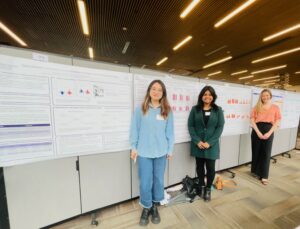Jiayin Xing, Mitra Kumareswaran, and Sarah Ethridge (from left to right) presented findings from their work investigating prosodic traits of speech among individuals with autism at the 2024 Meeting on Language in Autism at Duke University.
Jiayin Xing, Ph.D. (6th year communication sciences & disorders doctoral student) presented a poster titled, “Gaze-Speech Coordination during Narration in Autism and First-Degree Relatives.” The findings illustrated that the differences in the coordination of basic lower-level skills, i.e., gaze and speech, may serve as mechanistic contributors to higher-level social communicative differences, with implications for clinical practices targeting narrative and pragmatic language in ASD.
Mitra Kumareswaran, M.S. (4th year clinical psychology doctoral student) presented a poster titled, “A Multi-Method Approach to Characterize Prosodic Traits among Children with Autism Spectrum Disorder and Related Neurodevelopmental Disabilities.” This project utilized acoustic analyses and objective listener-based ratings to investigate prosodic characteristics of speech for children with autism, fragile X syndrome, co-morbid presentation of autism and fragile X syndrome, Down syndrome, and typical development. Findings suggest that each neurodevelopmental condition showed a somewhat different prosodic profile. Additionally, Listener-based ratings were more sensitive than acoustic measures for detecting subtle differences in prosodic behaviors, underscoring the need for more sophisticated acoustic measures in future research.
Sarah Ethridge (3rd year clinical psychology doctoral student) presented a poster titled, “Speech-Gaze Coordination During Rapid Naming in Autism Spectrum Disorder and Fragile X Syndrome: Implications for the Role of FMR1.” This study examines patterns of looking and speaking during a rapid automatized naming (RAN) task in individuals with autism spectrum disorder (ASD) and in individuals with fragile X syndrome (FXS). Results reflect a graded pattern of performance, with controls showing the most efficient pattern of looking and speaking, followed by autistic individuals, and, lastly, participants with FXS. Notably, variability in speech rhythm was inversely related to pragmatic language violations in ASD groups and directly related to FMR1-related genetic variation across clinical groups, suggesting speech rhythm and its relationship to complex language skills warrants further study.




